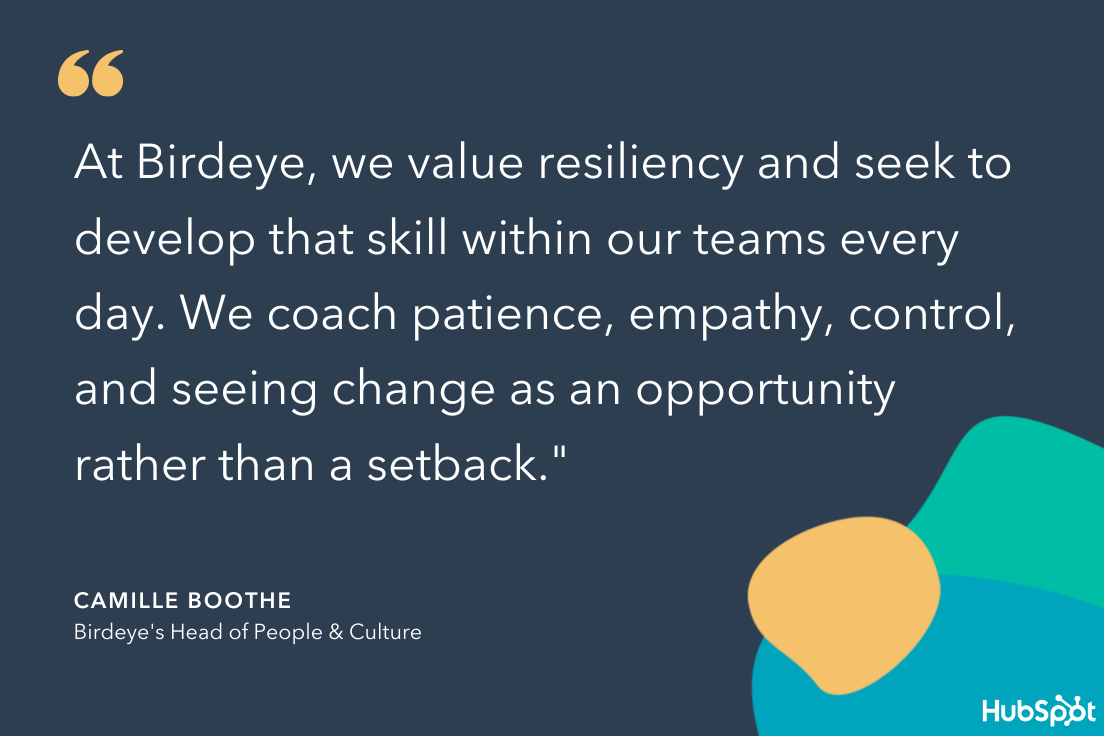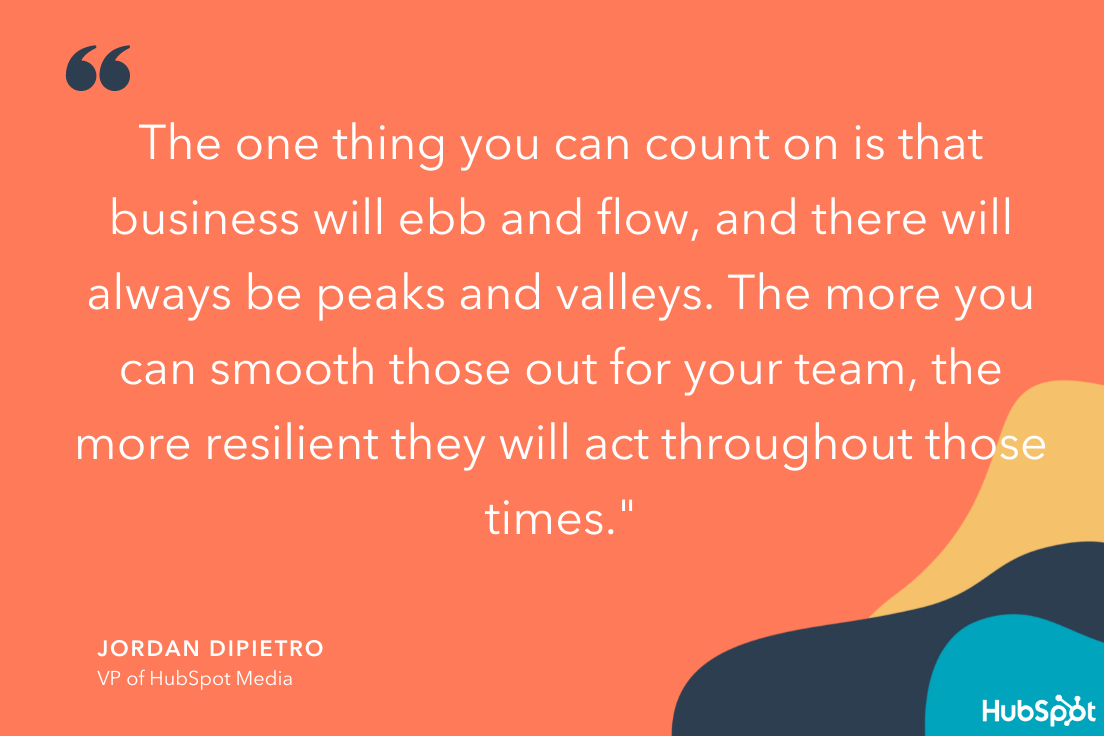To understand the importance of resilience in the workplace, let’s start with an example.
Let’s say your company has just been acquired by a major corporation. This means your organization is about to undergo some major changes — including your workplace culture, leadership structure, and even your team’s goals and objectives.
When it comes time to deliver the message to your marketing team, however, you’re surprised by their reactions. While there is some trepidation, most of your employees are upbeat, positive, and excited about the new opportunities and challenges ahead of them.
Their reaction doesn’t mean they aren’t also hesitant, nervous, or unsure of the future. It simply means that your team feels secure, confident, and capable of taking on those new challenges, whatever they may be.
This is the power of workforce resiliency.
Here, we’ll dive into why workforce resiliency is one of the strongest predictors of long-term employee satisfaction and retention. Plus, how to build a more resilient workforce, according to leaders who’ve done it.
What is workforce resilience?
To understand workforce resiliency, we first need to define what resiliency is.
As Merriam-Webster defines it, resiliency is “an ability to recover from or adjust easily to adversity or change”.
Essentially, a resilient person is someone who can adapt well to life’s unexpected challenges, stresses, and uncertainties.
Birdeye’s Head of People & Culture Camille Boothe told me, “When I think about resilience, certain thoughts come to mind — like adaptability, the ability to recover quickly, inner strength, and the ability to navigate challenges with a positive state of mind.”
So … what does resiliency matter for the workplace?
Workforce resiliency is, simply put, a group of employees who feel stable, secure, and capable of handling a workplace’s challenges, daily stresses, and organizational changes without losing engagement or motivation.
As Boothe puts it, “Why is resiliency important in the workplace? Because many employees cite workplace stress as the #1 stressor in their lives. That is why building a strong culture of resilience is essential for the success and well-being of employees.”
To put workforce resiliency into context, consider the past two years: Most businesses have made large-scale changes as a result of the pandemic.
Many companies shifted to an entirely remote lifestyle, and then shifted again towards hybrid or in-person once restrictions had been lifted.
Some leaders quit; while others made drastic changes to their strategies, goals, and future vision.
And yet … some businesses saw much higher turnover rates than others. Why is that?
Ultimately, the more resilient your workforce is, the more adept they are at handling business changes and industry shifts without feeling too much frustration, distrust, or uncertainty over how those changes will impact their livelihood.
Essentially, resiliency builds the opportunity for flexibility.
On the flip side, a non-resilient workforce is one that feels vulnerable, mistrustful of leadership, or tired and de-motivated. These are the workers who are most likely to quit, or who feel incapable of handling workplace changes with any sense of confidence or security.
Workforce resiliency is a strong component of long-term employee retention, and can help you build and maintain an effective and engaging workplace culture even when difficult situations arise. It’s important to consider workforce resiliency as the necessary backbone of any effective, strong company culture. Without resiliency, all the beer-on-tap and ping pong tables in the world can’t deter your employees from leaving.

Benefits of Workforce Resilience
If you’re still unsure of the benefits of workforce resiliency, let’s consider the data:
- BetterUp found highly-resilient people were 31% more productive during the pandemic than low-resilience workers.
- BetterUp also found resilience led to higher innovation (+22%), higher cognitive flexibility (+20%), and more novelty of ideas (+20%).
- ADP Research Institute found engagement and workplace resilience to be positively correlated — in fact, engagement explains 64% of resilience.
- ADP also found workers who experienced at least five changes at work were 13.2X more likely to be highly resilient.
All of which is to say: Work can be hard, and it can be particularly difficult to remain productive at work when an employee’s life is shifting dramatically as a result of unforeseen circumstances (like, say, a pandemic).
Resiliency, then, can help mitigate these stresses by providing a ‘safety net’ around the employee and helping them remain focused, positive, and engaged even during stressful times.
So — that’s all well and good. But, as a leader, how do you build resiliency? And, perhaps even more importantly, how do you maintain it?
How do you build workforce resilience?
1. Bake it into your employee initiatives.
To start, I spoke with leaders across organizations at Birdeye, Plecto, Alyce, Casted, and HubSpot to uncover tactical methods for developing resiliency in your workforce.
Boothe told me, “At Birdeye, we value resiliency and seek to develop that skill within our teams every day. We coach patience, empathy, control, and seeing change as an opportunity rather than a setback.”
She adds, “We recognize the factors that lead to resilience include optimism, balancing difficult emotions, and a sense of safety in a strong support system,” Boothe told me, adding that they’ve focused on three key initiatives at Birdeye to strengthen resiliency.
These include:
- Focusing on physical and mental health. Birdeye provides unlimited PTO and mental health days companywide for employees to rest and rejuvenate as needed. This gives employees a mindset to stay relaxed, even in the face of stressful situations.
- Flexible work schedules. Birdeye is in a primary work-from-home mode which allows employees to gain better work-life balance and stress management.
- Employee Resource Groups (ERG)/Social Connections. Birdeye builds relationships and connections for employees to leverage for support, as well as participate in forums and discussions on Mindfulness and Meditation.
Boothe adds, “We see resiliency as a competitive advantage and feel that building resilience is just good business sense.”
Along with employee resource groups, you might consider looking into trainings specifically focused on building resilience.

Additionally, you might consider offering your employees the chance to choose which employee benefits matter most to them, and enabling them to invest in whichever perks would best suit their lifestyles.
As Alyce’s VP of People, Tori Oellers, told me, “The ‘power of choice’ is a core tenant of our platform. and we see first-hand how successful campaigns can be when you put the choice in the hands of recipients. We take that same philosophy with many of our benefits.”
She adds, “Rather than carving out various specialized programs and partnerships, we have made it simple by allocating budget to various stipends that provide our team the power of choice to utilize the benefits in a way that is supportive for them as an individual.”
Oellers told me, “Recognizing and operationalizing ways to recognize your people as individuals ensures that each person is getting what they need to be successful and foster resiliency.”
Finally, providing educational resources for your leaders to train themselves on building agility in the face of adversity can help you effectively strengthen resiliency from the top-down. The Agility Factor, by Christopher G. Worley, Thomas Williams, Edward E. Lawler III is a good option for helping your leaders’ uncover how to build agility — and thus resilience — within an organization.
2. Emulate resiliency as a leader.
To build resilience in your workforce, you’ll want to emulate it as a leader. For instance, let’s say you’re delivering the difficult news that leadership has decided to cut budgeting for a marketing project that’s already in-the-works.
As Jordan DiPietro, VP of HubSpot Media, told me, “Your team is always looking to you as their leader for guidance, strategic direction, and advice — and they’re also looking to you as an emotional compass. If you get way too high, or way too low, they will ride those waves with you.”
He adds, “As someone leading a massive team, I’ve needed to figure out a way to stay more even-keeled. For some people that’s easy because they are naturally steady and composed. However, I tend to be less equable — so I have to work hard to not let that reflect in my leadership.”
To remain steady during stressful or tumultuous times, DiPietro recommends leaders aim to minimize meetings and outward communication on days when they’re feeling overly stressed. On the flip side, he suggests leaders also attempt to curtail too much excitement — while it’s important to celebrate your team’s successes, you don’t want to go overboard with your emotions in either direction.
DiPietro adds, “The one thing you can count on is that business will ebb and flow, and there will always be peaks and valleys. The more you can smooth those out for your team, the more resilient they will act throughout those times.”
Additionally, as a leader you can emulate resiliency by modeling flexibility. As Lindsay Tjepkema, CEO and co-founder of Casted, told me, “At Casted, we prioritize flexibility and allowing team members to choose what a flexible workday looks like to them — whether that’s working the conventional 9 a.m to 5 p.m., taking long lunches to attend a favorite workout class, logging off earlier some days to spend time with kids before they go to bed, or whatever suits each individual.”
Tjepkema adds, “If we want our teams to believe that we value flexibility, we have to model it. I share my own needs for flexibility openly with the team. They know if I have a hair appointment or a family event. When they see me or another leader communicating our availability and using that flexibility, it empowers them to do the same.”
Ultimately, your resilience as a leader is contagious. In fact, highly-resilient team leaders have direct reports who experience 52% less burnout, and have roughly 80% lower intention of leaving the organization.

3. Focus on the physical and mental health aspects of resiliency.
Did you know people are 3.5X more likely to be resilient if they have good physical health?
Providing your employees with the resources necessary to remain strong phsyically — including fitness reimbursements, flexible work schedules to go on walks or runs during lunch, and even fun workplace fitness competitions — is vital for ensuring long-term resiliency.
For instance, as CEO and Co-founder of Plecto, Kristian Øllegaard, told me, “We’re an ambitious company and thrive on striving to be the best, so contests are a natural fit for the team. Most recently, we challenged the whole company to a push-up competition! The motivation to get involved and outperform colleagues was felt company-wide. This kind of fun-loving team spirit is what makes Plecto the place to be, where we build resilience and genuine relationships.”
If your workers are burnt out, exhausted, and depleted, they won’t have the energy to take care of their physical health, and it will ultimately take its toll on your employees, and your bottom-line.
Additionally, mental health is just as important as physical. Resiliency requires a healthy mindset where people are open to change and don’t dwell on the potential negative outcomes. This can only happen through practice.
Mindfulness and yoga are two effective opportunities to practice building resiliency, so consider how you might provide these options through a discounted mindfulness app subscription, or by bringing yoga to the office.
Additionally, therapy can be incredibly helpful for those who struggle to adjust to change, so perhaps you can try offering services such as Modern Health to your team for further mental health consultations.
Finally — encourage your team to take time off. As DiPietro puts it, “People are more resilient when they have had time to relax and reset! Nobody is meant to grind and not take breaks. The mind needs to untether from work and people need to feel like it’s okay to completely unplug without their team or performance suffering.”
He adds, “Leading by example isn’t enough here. Instead, every few months I ask each of my direct reports, ‘Hey, when is your next vacation?‘ If they don’t have one planned, I follow up in each one-on-one until they make plans. I have found that the directness of my approach gives my reports the feeling of freedom to actually take time off — because if they don’t, I’m going to keep bothering them about it. Force your employees to take time off. You will be rewarded for it!”
4. Practice transparency within your organization as a whole.
No matter how resilient your workforce is, they won’t feel comfortable or optimistic about company-wide or team-wide changes if they don’t understand the why behind the change.
This is where transparency comes into play. While you don’t have to over-explain, divulge confidential information, or apologize for your decisions, your team does deserve to understand the background context of the change and how leadership hopes it will impact the future of the company.
Øllegaard adds, “Since the beginning, business transparency and celebrating success have been at the heart of the Plecto culture. It’s no secret when it’s a record-breaking (or slower) month at Plecto. It’s hard to ignore the TVs around the office with dashboards of each team’s key performance metrics, which are broadcasted for everyone to see. What’s important is being completely transparent about how the company is performing.”
For instance, let’s say your CMO has issued a re-org — and, as part of the change, your social media team will move from under the Content Team VP to under the Brand Strategy VP.
When you deliver this news to your team, you’ll want to explain the context behind the decision.
For instance, you might say, “We’ve decided it makes more sense to have the social team live under Brand Strategy, since the Brand Strategy teams share a common goal of brand awareness. By contrast, most other Content teams share the goal of lead generation, which doesn’t make as much sense for our team’s purpose.”
Ultimately, transparency can build trust, which goes a long way towards making your employees comfortable, and even excited, about upcoming workplace events.
Workforce Resilience Examples
Finally, let’s dive into a few examples of workplace resilience to see how this looks in practice.
1. Staying calm with last-minute requests.
Your SEO team is getting ready for the holiday season when your VP tasks you with a major request: Please put together a memo of your 2023 vision, including areas of opportunity and pre-existing at-risk content, within one week.
When you tell your team, they immediately jump into action. They decide to stay after work, order takeout, and prep the doc together. Your employees are energized and confident that they can meet the deadline, and they’re excited about the challenge. By the end of the week they’ve created a flashy, engaging, compelling 2023 vision, and they can’t wait to hear the VP’s thoughts.
Why This Exemplifies Resilience
Even though the request is last-minute, your team feels comfortable handling the shift in priorities. A low-resilience team would’ve felt discouraged, frustrated, or uninterested in working on the task so close to the holidays, but this high-resilience team was able to shift their mindset quickly and look at the task from a more positive perspective: as a chance to impress leadership and get excited about the year ahead.
2. Taking risks and seeking out new challenges.
On Tuesday, your direct report comes to you with a pitch deck she’s put together in which she’s outlined why it’s a good idea to embed YouTube videos into existing blog posts.
It’s risky — your blog team hasn’t tried incorporating videos before, so there’s no prior evidence that it will be successful. However, your direct report has data from other brands to showcase how videos can increase blog traffic and time-on-page.
Why This Exemplifies Resilience
Risk-taking is all about willingly venturing into unknown territory … something a low-resilience person is unlikely to do. In this case, your employee is demonstrating resilience by showcasing her open-mindedness to test out new ideas and innovate, as well as her engagement and commitment to your team’s success. A low-resilient employee would likely feel less engaged and less willing to take risks.
3. Remaining positive and upbeat.
When you tell your employees your director is leaving your company for another role, they are saddened by the news. She has been an effective leader for the team for a number of years.
However, they are not fearful, mistrustful, or anxious. Instead, they understand this is the best next step for the director, and suggest ideas for a goodbye party. The vibe is ultimately positive and optimistic.
Why This Exemplifies Resilience
When a beloved leader leaves the company, it’s always a sad experience, but high-resilience employees can see the bright side of the situation and don’t dwell on the potential negative outcomes they could experience in their own roles as a result of the director’s departure. Instead, they trust your leadership and the organization at-large will continue to meet their expectations.
4. Handling constructive feedback well.
In a recent performance review, you tell your employee that he’s been underperforming. He’s missed a few deadlines, and recently arrived unprepared to a meeting with a client.
Your employee is unsurprised by this information, and responds calmly: “I really appreciate you taking the time to talk about this with me. I will give what you’ve said serious consideration, and reach out next week to plan a follow-up where we can discuss how I can improve my performance.”
Why This Exemplifies Resilience
A highly-resilient employee is likely effective at positive self-talk and harnessing optimism in the face of adversity. Additionally, resiliency enables people to handle rejection more smoothly by seeing it as an opportunity to grow.
Ultimately, you can’t always control the situations that arise in your workplace. But what you can control, if you’ve laid a foundation of resilience, is how your team reacts to those changes. The more resilient your employees are, the more likely they are to be happy, engaged, and motivated at work.
Taking the time to teach and foster resilience in your workforce isn’t easy, but in the long run, it will enable your team to more efficiently and willingly handle all the challenges thrown their way.

![]()



![Read more about the article 10 Best Mobile Friendliness Tests [+ What Does it Mean to be Mobile Friendly?]](https://www.dimaservices.agency/wp-content/uploads/2022/10/4ec26392-01d3-42c6-883a-7e018c4864de-1-300x26.png)
